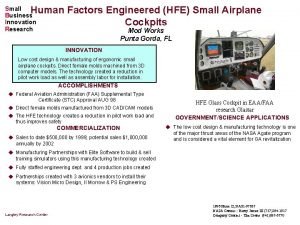Do D HFE VTAG 2020 1472 The UK
















- Slides: 16

Do. D HFE VTAG 2020 1472 - The UK Version: A Comprehensive Set of HSI Guidelines for all the Domains Robert J. Smillie, Ph. D. , C. Erg, CPE Foundation for Professional Ergonomics Chartered Institute of Ergonomics and Human Factors 3/12/2021 1

Background • In 2008, UK’s Ministry of Defence (MOD) issued Defence Standard (Def. Stan) 00 -250 Human Factors for Designers of Systems. • Similar to 1472, but more detailed at the time, it addressed: – – – – – People In Systems People Characteristics System Safety Training Operations, Maintenance, and Support Workplace Design Workplace Environment Equipment Design Living Spaces • In 2016, UK revised standard (Def. Stan 00 -251) to separate requirements from technical guidance. 2

Human Factors Integration Standard (Def. Stan 00 -251) Technical Guides Anthropometry: People Size Sensory Capabilities & Communication Cognitive Capabilities Physical Capabilities Motivation & Emotion Work Design Human Computer Interaction Information Presentation Control Technology Display Technology COTS/MOTS Equipment Display and Control Technologies Working & Living Spaces External Environment Social & Organisational Factors Equipment Health & Safety Workplace Health & Safety Human Contribution to System Safety Individual & Collective Training Competency & Retention Manning Recruitment & Selection Design for Maintainability & Supportability 3

People Characteristics • Anthropometry (155 pages) – Define Target Population – Generate Anthropometric System Requirements – Structural Anthropometry – Clothing and Equipment – Functional Anthropometry – Anthropometric Movement of Body Parts – Use of Manikins – Applying Anthropometric Data to Design of Systems • • • Sensory Capabilities and Communication (45 pages) – Hearing/Audition – Human Speech – Verbal Communications – Non-Verbal Communications – Principles of Vision – Principles of Touch – Principles of Smell Cognitive Capabilities (21 pages) – Psychological Issues – Stressors – Mental Workload Physical Capabilities (53 pages) – Strength – Physical Workload – Stamina 4

Equipment • • Human Computer Interaction (155 pages) – Key Principles – Affective Human-Computer Interaction – Behavioral HCI – Cognitive Human-Computer Interaction – Human-Computer Interaction Safety – Human-Computer Interaction Security – Human-Computer Interaction Environment – Ubiquitous Human-Computer Interaction – Human-Computer Interaction Support Facilities Information Presentation (76 pages) COTS/MOTS Equipment (12 pages) Design for Maintainability and Supportability (21 pages) • Display and Control Technologies (122 pages) – Key Principles – Overview of Display & Control Technologies – Visual Displays – Auditory Displays – Tactile Displays – Olfactory Displays – Direct Motor Controls – Indirect-Motor Controls – Gesture Interfaces – Use of Haptic Feedback in Motor Controls – Physiological Controls – Verbal Controls – Control Interactions in 3 D 5

Work Environment • Work Design (20 pages) • Working and Living Spaces (132 pages) – Workspace Design – Workspace and Task Lighting – Living Spaces • External Environment (49 pages) • Social and Organizational Factors (9 pages) 6

Safety • Human Aspects of Safety – Equipment Health and Safety (9 pages) – Workplace Health and Safety (9 pages) – Human Factors and System Safety (120 pages) • Key Principles • Project Safety Initiation, Committee, Planning • Preliminary Hazard Identification and Analysis • Risk Estimation • Risk and ALARP Evaluation • Risk Reduction and Risk Acceptance • Safety Requirements and Contracts • Hazard Log • Safety Case and Safety Case Report • In-service Safety Management System 7

Training and Personnel • Human Aspects of Training – Individual and Collective Training (65 pages) • • • Training Development HF Considerations in Training Social and Organizational Factors Training Environment – Competency and Retention (pending) • Personnel – Manning (pending) – Recruitment and Selection (8 pages) 8

Platform Specific • HFI for Land Vehicles (221 pages) – HFI for Military Vehicles – Preparation – Crew Ingress and Egress – Anthropometric Fit – Seating – Human Machine Interface – Cognitive Demands within Modern Vehicles – Situational Awareness – Physical Workload – Crew Sustainment • • HFI for Land Vehicles (cont. ) – Capacity and Stowage (C&S) – Manual Handling – Maintenance – Environmental Factors in Land Vehicle Design and Use – Training Safety High Speed Craft HFE Design Guide (Joint with US and others) (121 pages) 9

Other Guidance • Early Human Factors Analysis Methodology Guide (45 pages) • Human Centered Design for Military Human Computer Interfaces (155 pages) • Human Component in Weapon Systems (59 pages) 10

Human Factors Integration Management System • The Human Factors Integration Management System (Hu. FIMS) comprises Human Factors Integration (HFI) management and technical guidance for ensuring that Human Factors is appropriately implemented in the specification, procurement, provision and support of military capability. • Hu. FIMS contains a suite of HFI documentation and other guidance material. The policy, standard and guidance are central to the UK Ministry of Defence (MOD) approach to HFI. In particular, they are intended to direct and inform MOD staff and Industry teams about the required HFI activities and to help them manage the process. 11

Two US Efforts to use UK Standard for Guidance • Airforce – Bill Kosnik, 711 Human Performance Wing at Brooks AFB – Translate UK standard into a AF reference document with pointers to comparable US and Do. D HF research, references, and standards. – Break document into parts suitable for use as appropriate in other MIL STDs, Handbooks, etc, in conjunction with other services and agencies. – Duration of project, about 3 years and completed a final draft in June 2011, mainly converting English to American, MOD terms to Do. D terms, and converting UK policy and guidance documents to US and Do. D documents. – Verified HSI activities aligned with AF HSI processes. • SPAWAR – Bob Smillie, Space and Naval Warfare Systems Command – Compiled 350+ page handbook – Initiated in 2009 as a specification; completed in 2011 as handbook 12

Human Systems Integration Handbook Chapter 3 Tools and Techniques Chapter 2 General HSI Methods MOD-8 Chapter 4 Human Characteristics Chapter 5 Workplace Design Chapter 6 Environmental Factors 759 1472 743 759 1472 MOD-9 (9. 6 -9. 14) Information Sources DOD-HDBK-743 A MIL-HDBK-759 C MIL-STD-1472 F/G MIL-HDBK-46855 A MOD Def. Std. – H. F. for Designers of Systems Part 0: Human Factors Integration Part 4: HFI Methods, Tools, and Techniques Part 3: Section 8 – People in Systems Part 3: Section 9 – People Characteristics Part 3: Section 14 – The Environment Part 3: Section 15 – Work Equipment MOD-4 46855 -Sec 8 Chapter 7 Equipment Design 1472 MOD-14 759 1472 MOD-15 (parts)

Current 1472 H Approach • General changes made to the “G Change 1” revision (issued in 2019): – – – Added bridge design criteria. Corrected errors present in MIL-STD-1472 F. Deleted unnecessary information. Removed obsolete content and references. Added additional references. Hyperlinked Table of Contents, tables, figures, and embedded references to sections . • New sections added to “H” revision (Issued September 2020; 456 pages) – – – – Habitability Information Presentation Cybersecurity Handheld Devices Strength and Handling Extensive revisions and updates to all areas (e. g. , improved lifting equation) Hyperlinked Table of Contents, tables, figures, and embedded references to sections 14

Sharing a secret: 00 -250 Part 4 • Def Stan 00 -250 Part 4 – – Actually a text book Human Factors Methods Published in 2005 Standard issued in 2008 15

Getting Copies of Technical Guide • Go to: https: //sts. defencegateway. mod. uk/Login. aspx? Return. Url=%2 f%3 fwa%3 dwsignin 1. 0%26 wtrealm%3 dhttp%253 a%252 fsso. defencegateway. mod. uk%252 fadfs%252 fservices%252 ftrust%26 wctx%3 d 5254652 b-b 657 -493 b 92 ce-748869 ab 192 d%26 wct%3 d 2020 -1019 T 23%253 a 44%253 a 31 Z&wa=wsignin 1. 0&wtrealm=http%3 a%2 f%2 fsso. defencegateway. mod. uk%2 fadfs%2 fser vices%2 ftrust&wctx=5254652 b-b 657 -493 b-92 ce-748869 ab 192 d&wct=2020 -10 -19 T 23%3 a 44%3 a 31 Z • Click on “Create an Account” • Or, goggle ‘Mo. D Defence Gateway’ • Key is to get access to ‘Ki. D’ (Knowledge in Defence) 16
 Novec rates
Novec rates Sự nuôi và dạy con của hổ
Sự nuôi và dạy con của hổ Diễn thế sinh thái là
Diễn thế sinh thái là đại từ thay thế
đại từ thay thế Thế nào là hệ số cao nhất
Thế nào là hệ số cao nhất Ng-html
Ng-html Vẽ hình chiếu vuông góc của vật thể sau
Vẽ hình chiếu vuông góc của vật thể sau Thế nào là mạng điện lắp đặt kiểu nổi
Thế nào là mạng điện lắp đặt kiểu nổi Mật thư tọa độ 5x5
Mật thư tọa độ 5x5 Lời thề hippocrates
Lời thề hippocrates Vẽ hình chiếu đứng bằng cạnh của vật thể
Vẽ hình chiếu đứng bằng cạnh của vật thể Chụp phim tư thế worms-breton
Chụp phim tư thế worms-breton Quá trình desamine hóa có thể tạo ra
Quá trình desamine hóa có thể tạo ra Khi nào hổ mẹ dạy hổ con săn mồi
Khi nào hổ mẹ dạy hổ con săn mồi Các châu lục và đại dương trên thế giới
Các châu lục và đại dương trên thế giới Dot
Dot điện thế nghỉ
điện thế nghỉ






























